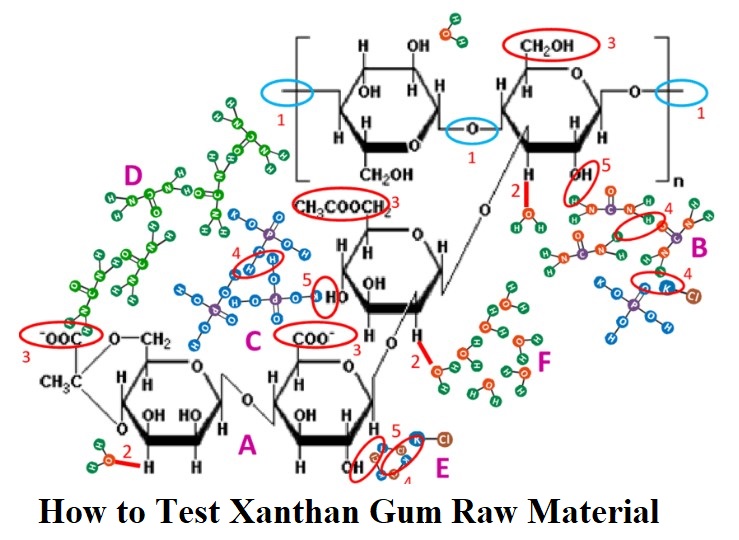
It is important to How to Test Xanthan Gum Raw Materials to follow industry standards, such as those set by the American Oil Chemists’ Society (AOCS), when testing xanthan gum. Xanthan Gum is a high molecular weight polysaccharide gum produced by a pure-culture fermentation of a carbohydrate with Xanthomonas campestris, then purified by recovery with Isopropyl Alcohol, dried, and milled. How to Test Xanthan Gum Raw Material contains D-glucose and D-mannose as the dominant hexose units, along with D-glucuronic acid, and is prepared as sodium, potassium, or calcium salt. It yields NLT 4.2% and NMT 5.0% of carbon dioxide, calculated on the dried basis, corresponding to NLT 91.0% and NMT 108.0% of Xanthan Gum.
Purpose
To ensure the quality of incoming raw material of Xanthan Gum.
Scope
It is applicable for the analysis of Xanthan Gum in the quality control department.
Responsibility
- Quality Control Manager
- Assist. Q.C. Manager
- Q.C Analyst
Abbreviations
- SAP: Standard Analytical Procedure
- QC: Quality control
Procedure
Equipment/Apparatus
- Analytical Balance
- Beaker
- Burette
- Capillary Tube
- Graduated Cylinder
- Melting Point Apparatus
- Nessler Cylinder
- Oven
- Pestle and Mortar
- Pipettes
- Test Tubes
- Titration Flask
Chemicals/Reagents
| Sr. # | Name Chemicals & Reagents | Qty |
| 1 | Distilled Water | 1 L |
| 2 | Potassium Chloride | Maximum QTY |
Physical Analysis:
How to Test Xanthan Gum Raw Material
Test of Physical Form:
Check the sample and confirm its physical form; it should be free flowing powder.
Test of Colour:
Confirm the colour of the material with naked eye; it should be white or yellowish white.
Test of Solubility:
It is soluble in water giving a high viscous solution, practically insoluble in organic solvents.
Test of pH:
Note the pH of 10% solution in water.
It should be 6.0 – 8.0.
Identification Test:
To 300 ml of water in a 400-ml beaker, previously heated to 80o and stirred rapidly with a mechanical stirrer add, at the point of maximum agitation, a dry blend of 1.5 g of Xanthan Gum and 1.5g g of locust bean gum. Stir until the mixture dissolve, and then continue stirring for 30 minutes longer. How to Test Xanthan Gum Raw Material do not allow the temperature of the mixture to drop below 60o during the stirring. Discontinue stirring, and allow the mixture to cool at room temperature for not less than 2 hours: a firm, rubbery gel forms after the temperature drops below 40 degree, but no such gel in a control solution prepared in the same manner with 3.0 g of Xanthan Gum and without locust bean gum.
Viscosity Test:
The viscosity at 24°C ±1°C is not less than 600 mPa•s. Add 3.0 g within 45 s to 90 s into 250 ml of a 12 g/l solution of potassium chloride R in a 500 ml beaker stirring with a low-pitch propeller-type stirrer rotating at 800 r/min. When adding the substance take care that agglomerates are destroyed. Add an additional quantity of 44 ml of water R, to rinse any adhering residue from the walls of the beaker. Stir the preparation at 800 r/min for 2 h whilst maintaining the temperature at 24°C ±1°C. Determine the viscosity within 15 min using a rotating viscosimeter set at 60 r/min and equipped with a rotating spindle 61.
Loss on Drying:
Method:
a) Dry the loss on drying bottle with cover at 105oC for 30 minutes, cool in desiccator and weigh (P gm).
b) Spread uniformly 1 g of substance in Loss on drying bottle and weigh (Q gm)
c) Dry at 100oC to 105oC temperatures for 2.5 hours (F).
Observations:
a) Weight of substance taken before process = Q – P = X g.
b) Weight of substance taken after drying = F – P = Y g
c) Difference (L g) = X – Y
Calculations:
L
% age of Loss on Drying = ——- x 100
X
It should not be more than 15% of its weight.
Quality Record(s)/Form(s):
6.1 The following Quality Records shall be generated and managed in accordance with the Procedure for Control of Company Quality Records.

